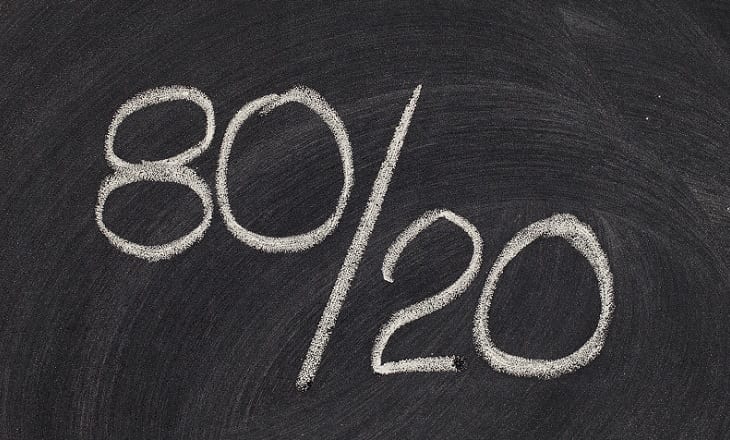The following article was written by Jens Chrzanowski, Member of the Management Board of Admiral Markets Group AS.
Hello,

Jens Chrzanowski, Admiral Markets
The leisurely summer continues, so my article this week is based on and inspired by an earlier blog article written by my trader colleague Chris Svorcik.
Have you heard about the 80/20 Rule, but wonder how it could help you achieve better results trading Forex?
This article discusses how you can apply the simple logic of 80/20 efficiently, which indicates that 20% of input, or effort, will create 80% of output, or success!
Sounds promising, right?
It’s a very effective tool that helps improve one’s trading performance and other aspects of business and life. We will explain exactly what the 80/20 Rule means, why it is effective, and how to apply it in trading.
What is the 80/20 Rule?
The 80/20 Rule states that a small amount (minority) of your effort will create and lead to most (majority) of your success.
For instance, in business, 20% of customers might lead to 80% of revenues. In trading, 20% of losing trade setups might cause 80% of losses.
The 80/20 Rule was discovered in 1896 by an Italian economist Vilfredo Pareto, which is why the Rule is also called the Pareto Law, the Pareto Principle, and the 80/20 Principle. Pareto discovered the odd balance when he examined that 20% of his peapods contained 80% of peas.
Are the numbers always 80/20?
No, 80/20 is just an example used to illustrate the odd relationship between small and large. In reality, the numbers can vary, but the main characteristic is that they are unbalanced and far off from 50/50.
For instance, a Forex & CFD broker might get 60% of profits from 15% of regular customers. This is also a valid example of the 80/20 Rule at work.
Traders and people in general tend to believe that each unit of effort or resource has (almost) an equal relevance for success. However, the 80/20 Principle bursts this bubble and shows that the numbers are highly skewed.
What can the 80/20 Rule actually measure?
Simply said, 20% (or equivalent) of work, or input, will create 80% (or equivalent) of success, or output.
The work, or input, could be anything: Resources, time, investment, effort, or skill in general, and your winners, losses, trades, and strategies for trading specifically.
The success, or output, can also vary: Profit, revenue, mistakes, membership, customers, and ratings in general and for trading.
Here are a few more practical examples:
- 20% of peapods contain 80% of peas (discovered by Pareto himself);
- 33% of your hobbies will demand 90% of your time;
- 10% of tasks at work lead to 70% of your career achievement;
- 25% of your mistakes when trading lead to 75% of your losses.
How do I actually use the 80/20 Rule for my trading?
As a trader, it is a critical and key concept to analyse your trading, performance, statistics, evaluations, analyses, trade setups, etc. Simply said, it is an all-round tool for analysing your trading business.
When we review our trading, statistics, and evaluations, the 80/20 Rule is what comes to mind as this is an excellent method for improving efficiency.
Here are three ways in which the 80/20 Rule can propel trading:
1. Trading Performance
The 80/20 Rule can improve your trading performance. For instance, I discovered that two mistakes were causing the majority of my trading losses. One of the mistakes was zooming into lower time frames and fearing irrelevant price action at the start of a trade.
Traders should check all of the aspects and more:
- Which parts of the trading plan impact losses and wins?
- Which tools, indicators, and strategies are causing the most losses and wins?
- Which time of the day or day of the week or month impact your stats?
- Which mistake types have a disproportionate impact?
- Which filters have a very small or a very large impact on the performance?
- Which losses and wins are triggered by the same entry type or trading system?
2. Individual Performance
The 80/20 Rule can improve your efficiency. For example, I noticed that my attention span is primarily disturbed by email and Skype, which I quite often turn off now to improve focus on trading and writing articles. Being available is important, but multitasking is not a strength. If you have an important task to finish, try to be unavailable for some time or only for really urgent matters. Skype, for example, allows you to apply appropriate filters. Easy, but many users of Skype and other messengers still don’t do that!
Things to keep an eye on:
- How much time and resources are spent on a task and why?
- What actions, behaviours, and ideas lead to most benefits?
- What kind of benefit does the task deliver and does it justify the time and resources?
3. Market Understanding
The 80/20 Rule can improve your understanding of how the financial markets and price action behave. In our view, the market tends to relate closely to the 80/20 Rule in the following ways:
Price action is ranging or trending 80% of the time, whereas 20% (or less) of the time price action is forming a top or bottom.
- Key lesson: Be cautious with expecting reversals.
Price action is behaving correctively 80% of the time, whereas 20% of the time it is moving with impulse or momentum.
- Key lesson: Momentum bursts typically last short.
Price action is not at an interesting spot on the chart 80% of the time, whereas 20% of the time price action is at an interesting spot.
- Key lesson: Be patient with waiting for the right trade setup.
Applying 80/20 to Forward Thinking
The 80/20 Rule is in a certain way related to Chaos Theory, which explains that below the apparent randomness of complex chaotic systems, there are underlying patterns, fractals, and repetition.
The 80/20 Rule is fractal in nature as well because the same rule can be applied over and over again (i.e., repetitively).
For instance, 15% of customers can deliver 75% of revenue. But when we use the same 80/20 Rule again for the second time, we might conclude that 70% of the group of 15% were approached by one member of the sales team (something he or she did was very valuable).
In trading, for example, a trader might conclude that 70% of total losses might be based on 25% of ill trade management decisions. The second attempt to apply the 80/20 Rule could indicate that the 85% of bad trade management decisions occur when setting up unrealistic targets.
The 80/20 Rule is form of analysis and offers a backward look and view. It is trying to learn from the past.
The 80/20 thinking is a forward-looking mindset. Once you know the rule, you can apply it and learn from it immediately, or soon enough.
The 80/20 Rule allows you to cut your losses and focus on your winners much quicker. This is the winning formula needed in trading – cut your losses short and let your winners run!
The 80/20 approach is a practical method that allows you to do just that. Search for patterns that you would otherwise miss and cut short losses, behaviours, and ideas that would otherwise keep going for months and years.
See you next week!
Feedback, concerns, requests, likes? Contact me via: [email protected].
Trading on margin carries a high level of risk, and this article should not be seen as advice or solicitation to buy or sell, but written for informational purposes.
